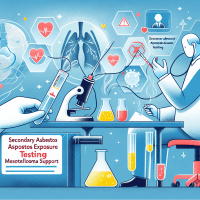Secondary Asbestos Exposure Causes: A Mesothelioma Guide
Hi, I’m a registered oncology nurse with over 10 years of experience guiding patients and families through the complexities of mesothelioma cancer. In this blog post, I share heartfelt insights and clear, compassionate guidance on understanding how secondary asbestos exposure can lead to serious health issues, including mesothelioma. Together, we’ll explore the medical facts, emotional challenges, and meaningful steps to navigate this difficult journey with hope and solidarity.

Understanding Secondary Asbestos Exposure
Secondary asbestos exposure, often known as secondhand or household asbestos exposure, occurs when individuals inadvertently inhale asbestos fibers brought home by workers. This indirect exposure is a critical factor in the development of mesothelioma cancer, as well as other respiratory illnesses like asbestosis and lung cancer.
As someone who has witnessed the toll of this condition on families, I understand how the invisible threat of contaminated dust can strike fear into the hearts of loved ones. My goal in this guide is not only to share medical insights but also to offer emotional support and a sense of community for those feeling isolated by their diagnosis.

The Medical Journey: Diagnosis and Staging
When it comes to diagnosing mesothelioma, early detection is key, yet it is often challenging due to latency in symptoms. Physicians may recommend several biopsy techniques such as thoracoscopy or thoracentesis to accurately assess the condition.
Diagnosis Techniques
I have seen firsthand how a biopsy, whether it is performed via a minimally invasive thoracoscopy or fluid analysis through thoracentesis, provides critical insights about the presence of cancer cells. Understanding these procedures can ease some of the uncertainty you might feel. I always advise patients to discuss all options with their healthcare team and seek a second opinion if needed.
Staging of Mesothelioma
Mesothelioma is typically classified into four stages, with Stage 1 indicating localized cancer and Stage 4 reflecting extensive spread. This staging helps doctors tailor treatment strategies to the unique circumstances of each patient. I encourage you to ask your medical team for a detailed explanation of what your stage implies and what treatment options are available.
Exploring Treatment Options with Compassion
Treatment for mesothelioma is complex and often requires a multi-modality approach. Options include surgery, chemotherapy, radiation, and in some cases, emerging therapies that are subject to rigorous clinical research.
How Treatments Work
Each treatment method is designed with its own purpose in mind. Surgical interventions may aim to remove or reduce tumor mass, chemotherapy works to target and kill cancer cells, and radiation therapy seeks to control local growth. Combining these therapies, often on a case-by-case basis, allows for more personalized care. I have always stressed that while treatment decisions can be overwhelming, taking time to understand each option and its potential benefits can empower you during this journey.
Emotional Well-being and Coping Strategies
The diagnosis of mesothelioma brings not only medical challenges but also profound emotional stress. I know many patients feel anxiety, fear, and isolation when confronted with such a diagnosis. It is essential to recognize that these feelings are natural, and there are numerous strategies to manage them effectively.
Managing Anxiety and Stress
In my practice, I have seen that small changes in daily routines, such as mindfulness exercises or guided meditation, can help alleviate anxiety. A simple technique, like the 4-7-8 breathing exercise, can offer immediate relief in moments of distress. Establishing a strong support network and talking openly about your fears with trusted individuals may also foster significant emotional relief.
Seeking Professional and Peer Support
Professional counseling can be an invaluable resource, as can support groups where you connect with others who truly understand your journey. Many organizations, like the Mesothelioma Applied Research Foundation, provide resources and community forums to help patients and families share experiences. Always remember: you are not alone in this fight.

I often reflect on how deeply intertwined our physical and emotional journeys are when facing mesothelioma. Sharing my own experiences and those of many brave souls has taught me that compassion and understanding light the way through even the darkest times.
Practical Steps and Resource Guidance
Beyond the clinical aspects, I firmly believe in equipping you with actionable tools to navigate daily life. Here are some practical steps that have helped many of my patients and their families:
- Schedule regular follow-ups: Stay in close contact with your healthcare provider for ongoing support and to monitor your condition closely.
- Connect with local support groups: Finding a community of people facing similar challenges can be incredibly healing. Consider searching for local mesothelioma support networks online or via reputable organizations.
- Explore legal and financial guidance: For those impacted by indirect asbestos exposure, legal options might be available. Reputable sources like the American Cancer Society can provide further details, though I urge anyone considering these steps to seek personalized legal counsel.
- Embrace self-care practices: Mindfulness, regular physical activity as tolerated, and maintaining open communication with loved ones contribute significantly to your overall well-being.
Building a Resource Toolkit
Below is a snapshot of some essential resources and a simple checklist I’ve personally found useful:
Checklist for Your Next Doctor Visit
- List your symptoms and questions regarding secondary asbestos exposure.
- Review your medical history, including any indirect exposure incidents.
- Discuss all possible diagnostic tests (e.g., thoracoscopy, thoracentesis) and their implications.
- Ask about the staging of the disease and what it means for your treatment options.
- Request referrals to support groups or counseling services.
This checklist is by no means exhaustive but is a starting point to ensure you’re fully prepared for your consultation.
Next Steps: Moving Forward with Hope
While facing mesothelioma can feel overwhelming, I want to assure you that there is always hope. I encourage you to take small, deliberate steps each day toward better understanding your condition and enhancing your quality of life. Rely on reputable sources such as the National Cancer Institute and the Mesothelioma Applied Research Foundation for current research and treatment guidelines (Information current as of May 2025).
Remember that every journey is unique, and while the path may be arduous, exploring avenues for both medical and emotional care will illuminate your way forward. Whether you are facing treatment options, navigating complex emotions, or preparing for conversations with family, know that compassionate support is always within reach.
Internal Links for Further Support
To enrich your journey, consider exploring additional articles on our site: Mesothelioma Treatment Options Explained and Coping with Mesothelioma: Emotional and Practical Guidance. These resources offer further depth and community insights that I hope will provide added comfort and clarity.
Thank you for taking the time to read this guide. I hope it serves as both an informative resource and a gentle reminder that you are not alone on this journey. Together, we can face the challenges of mesothelioma with courage, knowledge, and a supportive community.






